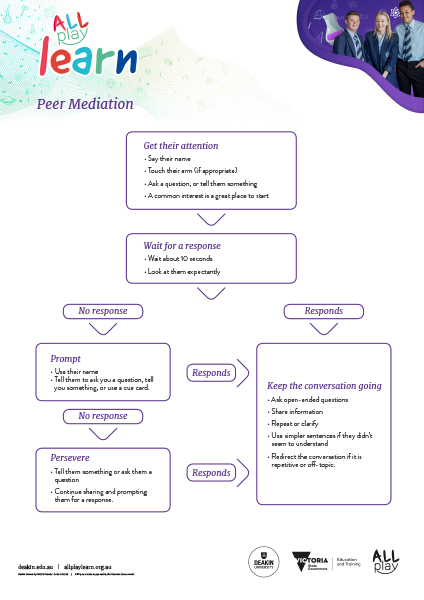
Peer Mediation and Group Work
- What is peer inclusion?
- Characteristics of effective peer inclusion
- Teaching peer mediation
- Group work
Research has found that peer mediation is one of the most effective approaches for supporting the inclusion of students and for the development of social skills at school. Peer mediation is particularly relevant for students who find joining in or engaging with peers challenging, such as students with autism.

So what is peer mediation?
Peer mediation involves teaching the peers of a student with a disability or developmental challenge how to communicate, include and interact with other students who may find communication or participation challenging. This involves moving from viewing the student’s unique communication and social abilities as a barrier, to recognising the impact of the environment around the student and focusing on changing this instead of the student. In this case, it is recognising that the student’s peers may need support in learning how to adapt their own communication and social approaches to enable them to be inclusive of others. Research suggests that peer mediation works best when a student with a disability is also participating in individualised communication or social skills training (e.g. regular therapy with an allied health professional). Bridging social and communication gaps can be achieved when the student AND their peers actively learn how to communicate and interact with each other.
What if a student or their family do not wish to have their disability disclosed to others?
Peer mediation can be used without identifying a student with a disability. Instead, specific social or communication challenges can be identified globally. For example, teachers can mention that a mediator could help students who find joining in challenging, and that being a mediator means students can learn how they can communicate with others who are quiet or don’t use words to communicate.
Could peer mediation negatively impact the wellbeing, inclusion or academic performance of peers?
When done with the right training and supports in place, research suggests there is no negative impact on the friendships and perceived ‘social status’ of peer mediators. In fact, the only impact that research has identified is that peer mediators are more likely to identify a student with a disability as a friend after being a peer mediator! Peer mediation typically includes a range of peers as mediators, which may also be important for ensuring positive outcomes for all.

Characteristics of effective peer mediation
- Peer mediation typically involves the inclusion of several peers as mediators. Including more than one peer means that a student has many friends to interact with and is not dependent on one specific peer (leaving the student without other options if the peer is absent). Interacting with many different peers also helps a student generalize the communication and social skills they are learning.
- Peer mediators who are well-liked and prosocial tend to make great mediators. It may also be important to choose peer mediators who have good social and communication skills.
- Regular training and practice are important for successful peer mediation.

Teaching peer mediation
Peers can act as social mediators both in and outside of the classroom. Role-play can help students acquire and consolidate skills in this area. Lunchtime clubs based on shared interests can provide great opportunities for students with autism to connect with others who share their interests. For an in-depth discussion of peer mediation see AllPlay Learn’s secondary professional learning course (Lesson 5 – autism). The following image outlines some of the key steps to teach peers to be mediators.
Group work
Training peers to act as mentors in the classroom can increase academic engagement and on-task behaviours in young people, while also building friendships. When done with the right training and supports in place, there is no or minimal impact on the ability of peer mentors to get their own work done, and peer mentors also experience positive benefits from their role. See below for key steps to teach peers to act as mentors in the classroom. For an in-depth discussion of peer mediation see AllPlay Learn’s secondary professional learning course (Lesson 5 – autism).Step one
- Provide an overview of relevant characteristics of students with a specific disability and the goals of peer group work
- Use strengths-based language
- Consider and discuss confidentiality
Step two
- Teach peers support strategies for class.
Step three
- Teach peers social or communication skills
Step four
- Talk to peers about when to seek assistance

